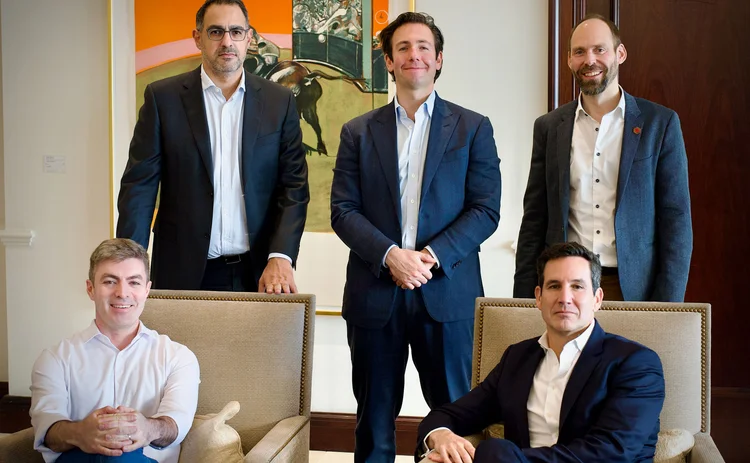
Interest rate derivatives house of the year: JP Morgan
Risk Awards 2025: Steepener hedges and Spire novations helped clients navigate shifting rates regime

It seemed like a sure thing – or as close to a sure thing as is possible in financial markets.
With US inflation seemingly under control, markets began 2024 convinced the Federal Reserve was about to embark on an aggressive easing cycle.
With six cuts expected over the course of the year, the stage seemed set for a rapid bull steepening, where the short end of the yield curve falls by more than the long end, and investors were rushing to position accordingly.
“The potential for a swift adjustment lower in policy rates and associated yield curve steepening was a very well telegraphed theme for 2024,” says Matthew Franklin-Lyons, global head of rates trading at JP Morgan. “Risk takers needed to get this right.”
The main issue was timing. Financing a bull steepener cost 6–7 basis points a month, meaning the longer the rate cuts took to arrive, the more the curve had to steepen for investors to turn a profit. A rebound in inflation could cause the Fed to forgo rate cuts, wrecking the trade entirely.
JP Morgan pitched a hedge – a conditional bear flattener, consisting of a pair of bought and sold payer swaptions – to help offset losses if rate cuts failed to materialise.
We consider ourselves a central pool of liquidity
Matthew Franklin-Lyons, JP Morgan
The market consensus on rate cuts meant one-versus-five-year three-month forwards were around 30bp steeper relative to spot, providing an attractive entry point for a flattener.
Implied volatility for three-month payer swaptions at the one-year tenor (3m1y) was also depressed due to the consensus around rate cuts. This meant hedgers could pay zero premium for the whole structure by selling payers on 3m5y at-the-money at a higher vol and buying 3m1y slightly in-the-money.
The idea was that if the Fed cut rates, the bull steepener trades would pay out and the zero-cost hedge would fall away. But if the cuts were pushed out, one-year forwards would reprice more than the five-year and the flattener would pay out.
JP Morgan traded conditional bear flatteners with several hedge funds at the start of the year, in varying sizes. And they came in handy when a series of sticky inflation prints in the first quarter pushed rate cuts into the distance. While the trade did not complete offset losses for clients that had bet heavily on the yield curve steepening, “it eased the burden of the steepener trade not working out”, says Craig Coggins, head of North America hedge fund and asset manager rates sales at JP Morgan.
The bank also put its huge balance sheet to work for clients that saw a steeper yield curve as a threat to their strategies. One hedge fund in particular wanted to protect its equity portfolio against a worsening macro environment – resulting in one of the year’s biggest rates trades.
The hedge JP Morgan came up with was curve caps – options that pay out if the basis between two points of the curve is above a certain strike. The problem was that curve caps typically trade in sizes of around $1 billion. The client wanted to do more than $25 billion notional. JP Morgan executed the full amount in the space of a few days.
The rates desk also suggested adding an equity contingency on the S&P 500 to a significant portion of the position to cheapen the trade.
“If what you’re trying to protect is a risk-off event, for example, a sell-off in equities, you can include a contingency that this will only pay out if equities move lower. It’ll give you more gearing to what you’re trying to protect against, and it will end up bringing the cost per clip down,” says Coggins.
As soon as they received the risk, JP Morgan’s rates traders hit the phones and managed to offload $15 billion to a hedge fund in a single clip of curve-cap spreads, where the client buys one strike and sells another on the same curve pair. Most of the remaining risk was recycled within three days using similar structures, leaving JP Morgan flat and the client sleeping easier at night knowing their equity exposure was hedged.
Escape velocity
As investors tried to second-guess what the Fed would do, JP Morgan’s linear rates desk was aggressively quoting on voice and electronic channels, with the conscious aim of pulling in as many trades as possible to boost the chances of finding offsetting positions.
Higher internalisation rates mean fewer trades going to interdealer venues, reducing market impact (and the fees the bank pays to trading venues). It also insulates JP Morgan from the risk of interdealer liquidity vanishing during big market moves, as most of its liquidity is coming from clients.
The pull of becoming a client flow-driven franchise also led the bank to embrace direct API trading, which allows clients to stream firm prices and execute direct from their execution management systems.
JP Morgan offers direct APIs for on- and off-the-run Treasuries and strategies including curves, butterflies and rolls, with more than 10% of its entire flow now executed this way. German, French and Italian government bonds were added earlier this year, to go with emerging markets swaps that are not traded on electronic platforms, such as Polish zloty, South African rand and Mexican peso.
While some dealers are reluctant to offer direct APIs for fear of being latency-arbitraged, Franklin-Lyons has no such concerns, noting that bringing in more liquidity simply cements the bank’s position as a flow hub.

“We consider ourselves a central pool of liquidity,” he says. “We have achieved escape velocity in such a way that routing all inquiry types into JP Morgan maximises liquidity for clients and our ability to risk transfer.”
That message is being heard by some of the biggest clients on the Street, who time and again mentioned JP Morgan as a top counterparty.
“JP is the one bank that knows the phone will always be ringing. They’re best in class in 90% of the instruments we trade, they have superior traders, salesforce and technology to monetise and provide flows for clients,” says a rates trader at a large hedge fund.
“I’ve been sat here for several years,” this person adds, “and they’ve never been outside the top three in dollars.”
While the US is home turf, JP Morgan has done even better this year in euro interest rate swaps, where its market share is now bigger than in dollars, despite extra competition from regional players. It also secured top spot for euro swap risk traded on both Tradeweb and Bloomberg in 2024 through to the end of October.
The strategy in Europe is the same as in the US – to quote aggressively and capture as much flow as possible.
“We’ve been showing prices tighter than we’ve ever shown,” says Tom Prickett, head of Europe, Middle East and Africa rates trading at JP Morgan. “In some cases, it’s unclear if we would make money on a trade, but the principle of ensuring that in rates we quote very tight means that liquidity would be available to us when we need it.”
Slaying on Spire
The shifting rates environment also raised new questions about long-dated investments entered into via Spire, the multi-dealer bond repack platform.
Spire was created after Lehman failed in part to make it easier to novate trades between banks in a default scenario. In reality, the scope for transfers is narrow.
“What we had not necessarily provided for at inception was what would happen if a client chose or wanted to novate a structure to another dealer outside a swap counterparty default proceeding,” says Goya Subramanian, co-head of EU rates trading at JP Morgan.
When Credit Suisse ran into trouble, a number of clients approached JP Morgan about novating positions outside of a default scenario. The structuring team obliged, putting together tri-party legal documents and developing guides that served as a blueprint for the industry to follow.

The changing rates regime has also prompted more clients to look at restructuring positions, while others have wanted to substitute bonds posted as collateral. The ability to novate allowed JP Morgan to provide its own quotes for restructuring payoffs or collateral, introducing competition into the process for the first time.
Since August 2023, the bank has novated eight Spire positions totalling €420 million.
A source at one European insurer says they have novated a few transactions to JP Morgan after the bank suggested a collateral switch that made sense for the investor and offered a better return than its existing bank.
“The thing I really appreciate about JP is that they’re pushing to standardise the novation framework into a standard process for Spire issuances. When this process is adopted by other banks, they will eventually all be in the position to do exactly the same, and then will be able to provide the long-term flexibility requested by investors,” he says.
“A full open window on all participating banks will help them be more aggressive on restructurings – it’s a clear step forward for the Spire structure.”
Breaking the lock
Spire isn’t the only commonly used structure JP Morgan has tweaked recently. The bank also improved one of the most common hedges for bond-issuing corporates – the Treasury lock.
The trade allows corporates to lock-in a rate ahead of an expected bond issuance. If rates are lower when the bond is issued, the corporate pays a lower coupon, but has to pay the bank the difference between the locked rate and spot.
This not only creates a liquidity risk for the corporate but also has an immediate and sudden impact on its cash flow statement, while hedging accounting rules mean the earnings impact of the loss is spread out over time. For corporates that are sensitive to cashflow impacts, this unknown hit can restrict their ability to enter the hedge in the first place.
Corporates can request to defer the payments once they’re due, but this extends the period of uncollateralised risk for the bank and generates derivatives valuation adjustment (XVA) costs that are unknown when the trade is struck.
JP Morgan came up with a structure for one large US corporate where both parties agree to defer the cash payment over a pre-determined period at inception, regardless of whether it is in favour of the bank or corporate – meaning expected XVA gains or losses can be priced-in upfront. The terms also give the corporate the flexibility to accelerate gains in its favour, or to adjust the period of amortisation.
“It was a complex problem but was meaningful to us. And it’s now replaced how we enter nearly every single corporate-level hedge at this company,” says a treasury source at the US corporate.
Gregg Geffen, head of North America corporate rates at JP Morgan, says the structure has now been adopted by other clients, with billions of notional traded.
Only users who have a paid subscription or are part of a corporate subscription are able to print or copy content.
To access these options, along with all other subscription benefits, please contact info@risk.net or view our subscription options here: http://subscriptions.risk.net/subscribe
You are currently unable to print this content. Please contact info@risk.net to find out more.
You are currently unable to copy this content. Please contact info@risk.net to find out more.
Copyright Infopro Digital Limited. All rights reserved.
As outlined in our terms and conditions, https://www.infopro-digital.com/terms-and-conditions/subscriptions/ (point 2.4), printing is limited to a single copy.
If you would like to purchase additional rights please email info@risk.net
Copyright Infopro Digital Limited. All rights reserved.
You may share this content using our article tools. As outlined in our terms and conditions, https://www.infopro-digital.com/terms-and-conditions/subscriptions/ (clause 2.4), an Authorised User may only make one copy of the materials for their own personal use. You must also comply with the restrictions in clause 2.5.
If you would like to purchase additional rights please email info@risk.net
More on Awards
Market liquidity risk product of the year: Bloomberg
Bringing clarity and defensibility to liquidity risk in a fragmented fixed income market
FRTB (SA) product of the year: Bloomberg
A globally consistent and reliable regulatory standardised approach for FRTB
Best use of cloud: ActiveViam
Redefining high-performance risk analytics in the cloud
Best use of machine learning/AI: ActiveViam
Bringing machine intelligence to real-time risk analytics
Collateral management and optimisation product of the year: CloudMargin
Delivering the modern blueprint for enterprise collateral resilience
Flow market-maker of the year: Citadel Securities
Risk Awards 2026: No financing; no long-dated swaps? “No distractions,” says Esposito
Pricing and analytics: fixed income – Quantifi
Quantifi delivers high-performance, transparent and adaptable pricing and risk analytics for fixed income and credit markets
Derivatives house of the year: Citi
Risk Awards 2026: Rev up, RWAs down, as US bank gets back on track (with added XiNG and XiP)








